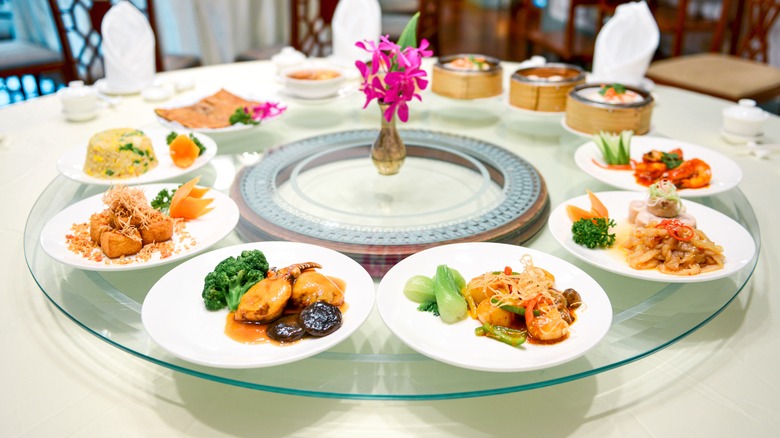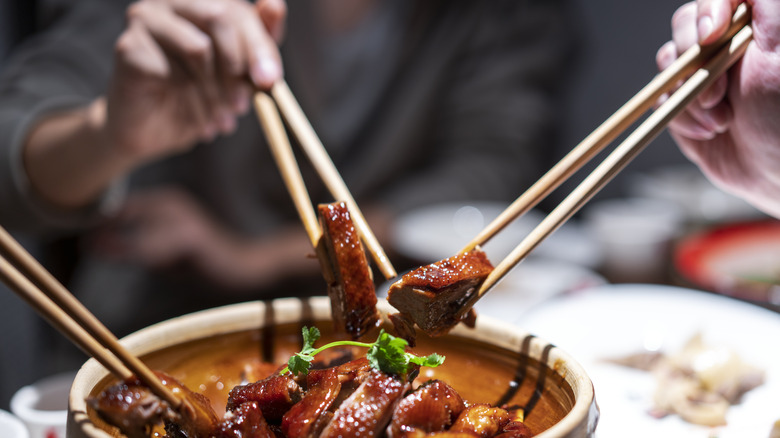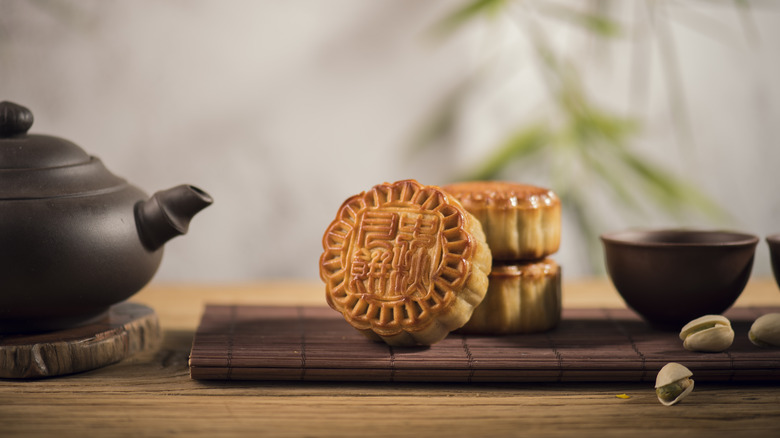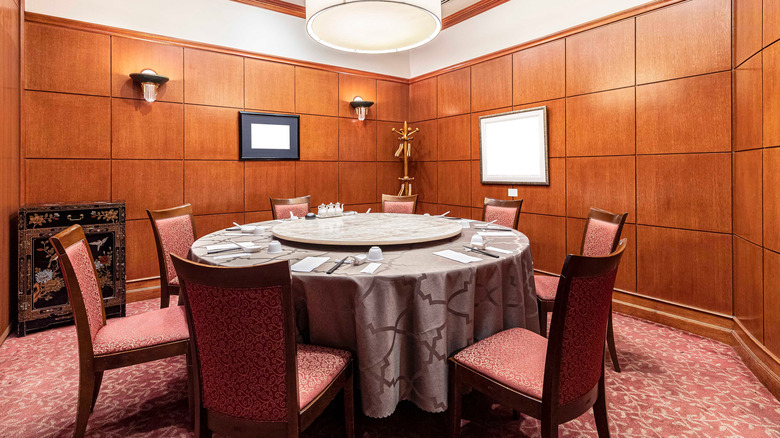The Traditional Reasons Chinese Restaurants Have Round Tables
Sometimes topped with a Lazy Susan, the circular tables in Chinese restaurants epitomize cultural dining etiquette, social customs, and practicality. Prior to their adoption in 1644, per Making Modernity in East Asia, the Chinese used rectangular dining tables. The angular tables lined the walls while a theatrical performance took place in the center of the room during formal gatherings. The table set-up offered an excellent view of the entertainment but did little to facilitate chitchat across the room.
The adoption of the round table signified the beginning of a more egalitarian view of social hierarchy. It functioned the same way that round tables supposedly did for King Arthur's knights — when seated at a round table, rankings didn't matter. Because a round table lacks a distinct head or a foot, as rectangular-shaped tables do, it makes everyone equal regardless of social or financial status. And given that meals in Chinese culture are where people socialize, the round shape allows people to easily converse, if not face-to-face, nearly so.
In reality, the social hierarchy still dictates Chinese table etiquette for some. It is tradition for the person of honor to sit in the chair that either faces east or the front door. Those who sit on either side of the guest of honor also enjoy greater social rank. If you happen to be the host, count on sitting next to the service entrance. And plan on footing the bill, too, though paying is considered an honor, not a punishment, in Chinese culture.
Round tables facilitate communal eating
Chinese meals are usually served in a communal style at these round tables. Everyone shares food on serving platters placed on the Lazy Susan in the center of the table. The host typically orders the food in the restaurant, asking the server for a variety of dishes with disparate flavors and textures to create an interesting meal. No one eats until the guest of honor, host, or eldest member at the table commands everyone to do so or starts eating first.
Once the meal commences, etiquette demands that people turn the Lazy Susan in a clockwise direction when serving themselves more food. They are expected to bring their dishes closer to the Lazy Susan if needed rather than moving the communal dishes and grabbing food from the shared platters with communal utensils.
In the past, people used to eat directly from the communal platters. Whenever they wanted a bite of something, they stuck their chopsticks into that dish and then pushed the bite of food into their mouths. In one meal, their chopsticks could go from the steamed white rice to the platters of deep-fried fish and honey walnut shrimp before their chopsticks finally hit the noodles. Eventually, in the name of healthy communal eating, people began using serving spoons or chopsticks to fill their plates, not their mouths. From then on, the only food that the guests' chopsticks touched was the food on their own plates.
The reunion of family and friends
The round table also embraces Chinese philosophy and spiritual practices. Round is "yuan" in Chinese, and "tuanyuan" translates to reunion. As such, the unbroken circle of the table represents oneness and reunion, as in family and friends coming together for a reunion after being apart. Just as the hands on the clock must eventually return to their starting point, so too must those who hold one another dear. This concept also signifies many things, like harmony, prosperity, and even harvest.
Additionally, the circle is the shape that most people associate with the Tao and the yin and yang symbol. Because of this, it is an important shape during auspicious occasions in Chinese culture, such as the Mid-Autumn Festival and the Lunar New Year. Symbolically, it's no small thing that people sit at round tables and eat round foods like pineapple tarts, tangyuan (glutinous rice balls), and mooncakes during these holidays.
The practical side of round tables
However, it's fair to say that the round table's popularity has just as much to do with ease of use as it does auspicious occasions. Many square dining tables are difficult to move around, requiring that they be carried in and out of doors, up and down stairs, and around tight corners in one piece. The round tables, on the other hand, are constructed in such a way that allows for the top of the table to be removed from the legs. The Lazy Susan is typically free-standing as well, meaning it can be taken off the table if necessary. Those tasked with moving the tables can dismantle them and carry them easily.
The wood from which they're made is usually less expensive than some of the wood that many rectangle tables are constructed from. Aside from this, many of them come complete with an extra leaf that can be added or subtracted, depending on the number of guests that are expected to be sitting around the table. In other words, form is supported by function and vice versa. After all, one of the benefits of a round table is that it allows more people to sit together for the meal. The table expands or contracts to fit the number of invitees. All this means that no one misses a meal due to a dearth of places to sit.



